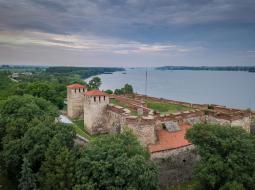Thessaloniki gets ready for its metro launch in November
The underground rapid transit lines have been under construction for almost two decades due to various project delays
 TheMayor.EU logo
TheMayor.EU logo 
Vidin has a rich history dating back to ancient times. The city’s origin can be traced to the ancient Celtic settlement of Dunonia. There the Romans built a fortress named Bononia which had a great strategic importance within the boundaries of the Roman Empire. As a result of the Avar invasion in the sixth century, the cultural strata shifted and Bononia became the center of the district.
The Byzantine emperor Justinian the Great (527-565) strengthened the fortress in order to deter the Slavic tribes. The town of Bdin entered the state of Khan Asparuh (681-701) as soon as it was established at the end of the 7th century. Later (in the IX century), Bdin was among the ten military-administrative units of the First Bulgarian Kingdom.
During the era of the Second Bulgarian Kingdom, the port city was not only a political center of the northwestern Bulgarian lands, but also a commercial and literary center. The city, ruled by Ivan Sratsimir (1355-1396) of the Shishman Dynasty, was the last medieval Bulgarian capital.
With the conquest of the Vidin fortress in 1396 by the Ottoman Turks, the medieval Bulgarian state was brought to an end, but as a border area within the Ottoman Empire, Vidin retained its political, military and economic importance.
After the Liberation, the city was heavily influenced by Western modernist trends in culture and architecture. The dynamic development was demonstrated by newly built factories and active trade links along the great European Danube River.
During the Serbian-Bulgarian War of 1885, Vidin was besieged by the Serbian army, but its heroic defenders repelled all attacks and contributed to Bulgaria's victory in the conflict.
Located on the Danube River and 220 km away from the capital Sofia, Vidin is the administrative and economic center of the municipality of the same name in northwestern Bulgaria. It has an important strategic advantage, as two major European transport corridors pass through the municipality - № 4 and №7. The Vidin-Calafat Danube Bridge is the second to connect Bulgaria and Romania and is of great importance for relations with Western Europe.
Vidin is the 21st largest city in Bulgaria. The Vidin district is the 15th largest among the 28 districts in the country, but it is the least populated.
The rapid industrialization in the 1970s and 1980s under Communism led to the establishment of the Vidachim Chemical Plant, which included the Vidlon Polyamide Fiber Plant, the Vida Car Tire Plant, the Mechanical Repair Plant and the Vidin Thermal Power Plant. The new livelihood brought a significant increase in the municipality’ population size, and Vidin was renowned worldwide for its exports of tires, water pumps, fine porcelain, men's shirts, cigarettes, wines and more.
During the transition to a market economy and privatization after 1990, industrial enterprises in the city declined rapidly, leading to depopulation of the district.
Due to its strategic location on the Danube River and on the main European corridors № 4 and № 7, Vidin has the potential to become a leading intermodal and interconnector center not only in Bulgaria but also in the Balkans.

Traces of different cultures – of Thracians, Romans, Proto-Bulgarians, Slavs, Byzantines and Turks can be found in Vidin. This is evidenced by a number of historical monuments and artifacts. Vidin is the only place in Bulgaria where Vidin's Holy Metropolis church, one of the largest synagogues in Bulgaria and a unique mosque, whose minaret ends with an inverted pike, are just a few meters away from each other. This co-existence between three religions - Christian, Judaic and Muslim - is a symbol of peace and tolerance.
The medieval Baba Vida fortress is considered an emblem of the city. It is part of the 100 National Tourist Sites of Bulgaria.
The Vidin region also takes pride in its preserved traditions, original local cuisine and quality wines.
Vidin, 2 Bdintsi square